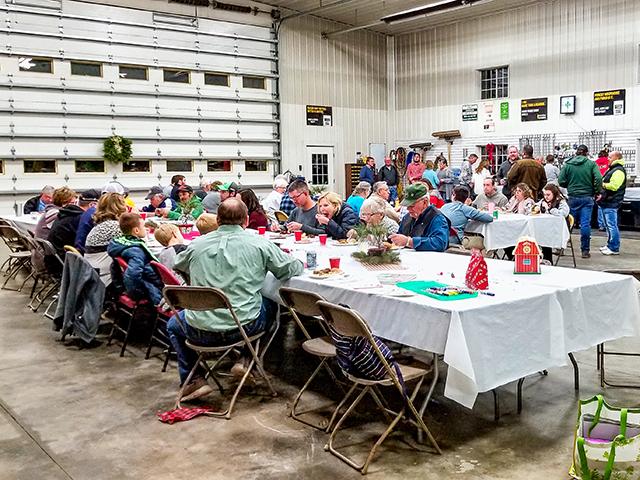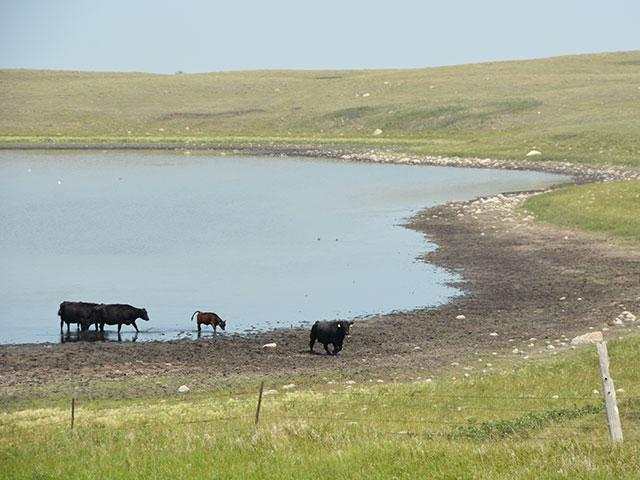Trying to Hang on to Cattle
Past the Scramble for Feed, North Dakota Cattle Producers in Drought Weigh Options
DICKINSON, N.D. (DTN) -- After some of the busiest months in recent memory, at least a few North Dakota sale barns this week saw fewer sales of cull cows and bulls.
As North Dakota comes out of one of the hottest, driest Junes on record, livestock producers are looking for any type of feed to hold on to their cows and calves -- at least until the calves are weaned. Their challenge with the drought is pastures have dried up, and they have already eaten away at their hay and feed reserves. And they are about to face another stretch of temperatures in the upper 90s over the next week or longer.
Hay was already short going into last winter. As spring arrived, producers continued hanging on, waiting for rains and grass, depleting any hay reserves they may have had in the process. When pastures didn't recharge, they started to consider options such as selling. With much of the western half of the country in drought conditions, similar scenarios are playing out for cattle producers in Montana, Colorado, South Dakota and farther west.
Roadsides across North Dakota this week were filled with tractors cutting, swathing and baling hay. Sweetclover is common in this hay, and farmers need to be aware of toxins. For more, please read: https://www.dtnpf.com/… .
Producers will also be allowed to hay or graze acres in the Conservation Reserve Program (CRP) after Aug. 1, though the state's congressional delegation in June asked USDA to open up emergency provisions of CRP before then.
Reflecting the eastward expansion of drought, Minnesota's governor and congressional delegation Thursday also wrote a similar letter to Agriculture Secretary Tom Vilsack, asking for early release of CRP acres. The U.S. Drought Monitor on Thursday raised drought intensity with some central Minnesota counties now in D-3 "extreme" drought conditions.
With a spreading drought, hay will continue to be in short supply, regardless of whether USDA opens CRP early. Hay from CRP ground won't sustain the cattle industry long but may give producers a better chance to wean their calves before they sell the cows.
HAY CONCERNS
At Stockmen's Livestock Exchange in Dickinson, North Dakota, the Thursday sale of 400 head was about one third of the volume of the weekly sale two weeks ago, and a whole lot lighter than a month ago when more than 2,000 head were sold. Larry Schnell, who co-owns the sale barn with business partner James Erickson, said the light sale on Thursday was partly due to producers trying to bale hay.
"We don't have much hay so that's why I think everybody is just getting out after it right now," Schnell said. "There are still plenty of cows that are going to be sold, but right now anybody who has a chance of getting hay is doing it because we're looking at least ten days of temperatures in the 90s coming up. So, that's why we're not seeing as many cattle today. But in a week or two we'll see those numbers go back up."
Jerry Anheluk, who ranches and farms north of Belfield, N.D., has about 600 cow-calf pairs. Anheluk has also been baling hay, getting roughly 1,000 pounds every 3 1/2 acres, he said, "which amounts to nothing. We can't cover our fuel or our labor costs, but we have no choice. We don't have to pay transportation to bring it in, but it's still a zero-sum game."
Anheluk is holding onto his cattle for now, but they are eating away at his reserves. He usually backgrounds his calves to add some weight before selling them to a feeder, but that's going to be out of the question this year, he said.
P[L1] D[0x0] M[300x250] OOP[F] ADUNIT[] T[]
"Buying hay is OK if you have one horse in the barn, but you are not going to feed cows by buying hay," Anheluk said.
Anheluk lamented the conversion of pasture acres to crops and the decline of CRP, which has gone from a high of 36 million acres nationwide down to near 20 million acres now. "This is the year that would have saved us," Anheluk said.
HIGH SALES VOLUMES
In the north-central area of North Dakota, the Rugby Livestock Auction sold 1,400 head in its regular Monday sale, which is the lightest sale that auction has seen in recent months, but still nearly five times the normal number of cull cows sold this time of year. Rugby also typically has been seeing 600 to 1,000 cow-calf pairs being sold off every week this summer. The sale volumes of cull cows and pairs was so high in late May workers had to add extra pens.
"It was a lot of work to get through that," said Cliff Mattson, owner of the Rugby Livestock Auction. "It was something we've never experienced and never had to deal with."
Normally, Rugby might sell 30 to 40 cow-calf pairs in a month when a rancher is short on grass. In June, the sale barn sold more cow-calf pairs in one sale that it had sold in the last six years during June. "We normally sell 60,000 to 65,000 head of everything in a year, but we've already eclipsed the 50,000 head mark, and we've got six months to go," Mattson said.
Mattson said producers are selling off herds with genetics it took years to build. It will take years again to rebuild those herds, and the decline in cattle will hurt local communities long-term as well, he said.
"The money they are getting for them now compared with what they will have to pay when they try to build the herds back up -- it's going to cost a lot of money," Mattson said. "From the local communities, you know we rely on the ag industry for support and the local co-ops, it just goes down the line, so it affects everybody."
The Dickinson auction was also selling roughly 800 cow-calf pairs a week until the end of June. Most of the cow-calf pairs were heading several hundred miles east beyond the Mississippi River where pasture conditions are significantly better, he said. "Why we're not seeing more right now is, that the thought process now is, 'We'll hold on to the cows until we wean the calves, then we'll sell the cows,'" he said.
Mattson agreed a lot of producers are holding on to wean the calves, then a high volume of cows will be getting sold. "That's their main goal right now because feed is going to be an issue this winter. Nobody is going to have any feed."
A dry 2020 had already diminished hay production and most ranchers have fed out much of their reserves by now.
At least the high demand for cow-calf pairs back east and the high-dollar hamburger market are helping producers who are faced with selling right now. Prices for the cull animals is strong with beef demand remaining high.
"We've been very gratified as to how strong the pair market is, and the slaughter market," Schnell said. "We're selling slaughter bulls, the best of them, for $1 to $1.10 a pound, and we're selling a lot of 2,000- to 3,000-pound bulls. We're talking pretty good dollars. That's about as good as I've ever seen it, other than maybe for a short period."
HOLDING ONTO THE HERDS
Producers are looking for ways to hold on to as much of their herds as possible. Shane Sickler of Gladstone, North Dakota, said he came through winter with zero moisture in his fields. Most rains have been small, but winds didn't help. "That wind just takes all the moisture out of everything."
Sickler sold about 30% of his cow herd this spring but is trying to keep his younger cattle. "Were stocking them about half their normal numbers because the pasture is so bad," Sickler said.
Adam Lee runs 125 Angus cow-calf pairs near Plaza, North Dakota, but he expects he will be down to about 60 pairs this fall. He's been supplementing feed with a cake product, but he's been reluctant to sell cows so far. A few timely rains have helped delay those decisions. It's difficult because once he sells, Lee recognizes it will be hard to rebuild.
"Generally, guys don't sell their best stuff, right? So, when you buy cows back, you are going to get the mean ones, or the fence crawlers, or the ones that aren't producing a good calf. So, it can take years to buy back what you consider your best."
Bailie Graner, who farms and ranches near Mandan, North Dakota, said she and her husband have about 250 cows, but have sold 10% of their herd so far. They plan to keep as many cows as possible until next winter when they'll send them to a feedyard near Jamestown.
"It's cheaper to take the cows to the feed than to take the feed to the cows," Graner said.
Mattson said he also has ranchers who work for him who are taking their cow-calf pairs to feedyards in other states. That can be an expensive option for young commercial producers. "It's tough to justify putting that kind of money into them," Mattson said. "But one thing about North Dakota people, we love our livestock and we put a lot of time and effort into them. We want to do whatever we can to hang on to them."
For more on how North Dakota's grain farmers are faring during this drought, please read "North Dakota Farmers Struggle with Historic Hot, Dry Conditions" here: https://www.dtnpf.com/… .
Chris Clayton can be reached at Chris.Clayton@dtn.com
Follow him on Twitter @ChrisClaytonDTN
(c) Copyright 2021 DTN, LLC. All rights reserved.






